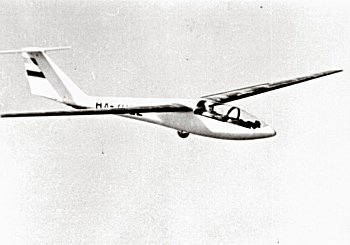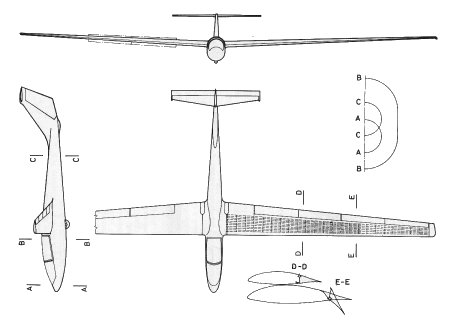HUNGARIAN
GLIDERS
1933-2000

Short history:
In 1964 it was decided by a group of young engineers of the factory's design bureau to create a performance glider, which would surpass in performance all previous Hungarian gliders. The design work had been started as a private venture, and the design was the runner up when the parent factory (Pest Area Machine Factory - PG) invited aircraft designs in 1965. The factory accepted the design to build, and the team, which started working at the beginning of 1967 on the production design, consisted of Lajos BENDE, Mihály KESSELYÁK, Pál KEREKES, Bálint MAGYAR, Ferenc MAJOR, György PAPP and Lajos TEKNYŐS. The glider first flew at September 18, 1969. After the test flights had been completed the Hungarian Glider Team got the glider for operational tests. In October, 1970 the wings of the glider were broken off in flight due to a severe pilot error. The glider was destroyed and the pilot lost his life. No more example was built.
The EV.1.K was certified for full aerobatics except negative loops.
Structure: All-metal
Wing:
The spar-less, laminar wing had a tapered planform. Split aileron and trailing edge airbrake were fitted. The latter took up the 40% of the wing's span and its total area was the 11,7% of that of the wing. The wing's airfoil was Wortmann FX 61-163 section up to the 50% of the span. There was a transition from this section to the FX 60-126 used at the wingtip. The aileron was not slotted, its nose remained within the airfoil's contour even when deflected extremely.
The wing had a monocoque structure and was stressed for severe turbulence usually encountered in wave-rotors. The structure of the wing's front part was of sheets bent to the required form and supported sparsely by ribs. The structure of the central part was a box structure, which consisted of ribs fitted between front and rear web-sheets, strengthened by Z-section longerons and sheet skin. The rear part of the wing was a light-metal sheet structure, which nested the control activating mechanism. There were no inspection holes on the wing, since deploying the trailing edge airbrake gave access to inspect the structure as well as the control mechanism. To get a smooth surface the skin-sheets were supported by polyuretan foam.
Fuselage:
The fuselage had a traditional light-metal structure consisting of frames, Z-section longerons and sheet skin. The elliptical cross-section fuselage had an aerodynamically smooth contour, into which the canopy was streamlined. The canopy had a fixed and an opening part. The pilot's seat was adjustable on the ground, however the backrest was adjustable in flight as well. The instrument panel had an integrated structure and was removable after opening up the fastening clamps. The landing gear consisted of a fixed wheel located under the c.g. of the loaded glider, a nose skid flushed into the bottom, and a small tail-skid.
The half-wings were attached to a central part integrated into the structure of the fuselage. This central part had a similar structure than that of the wing.
Tail unit:
The tail surfaces had a T arrangement.

| Dimensions: |
| Wing: |
| Span, m: |
15 |
| Area, m2: |
11,92 |
| Aspect ratio: |
18,87 |
| Chord (root), m: |
1,143 |
| Chord (tip), m: |
0,443 |
| Airfoil (root), m: |
FX 61-163 |
| Airfoil (mid-span), m: |
FX 61-163 |
| Airfoil (tip), m: |
FX 60-126 |
| Dihedral, degree: |
0 |
| Sweep, degree: |
-1,5 |
| Washout: |
Aerodynamic |
| Aileron: |
| Span, m: |
3,0 |
| Mean chord, m: |
0,175 |
| Total area, m2: |
1,1 |
| Balancing: |
Aerodynamic |
| Flap: |
| Type: |
None |
| Airbrakes: |
| Type: |
Trailing edge |
| Total area, m2: |
1,48 |
| Position, % of chord: |
On the trailing edge |
| Horizontal stabilizer: |
| Span, m: |
3,0 |
| Area, m2: |
1,2 |
| Elevator: |
| Span, m: |
3,0 |
| Area, m2: |
0,525 |
| Airfoil: |
NACA 63-210 mod. |
| Balancing: |
Mass |
| Trim: |
Yes |
| Vertical stabilizer and rudder: |
| Total area, m2: |
1,38 |
| Rudder area, m2: |
0,55 |
| Balancing: |
None |
| Fuselage: |
| Length, m: |
6,86 |
| Width, m: |
0,6 |
| Height: |
0,82 |
| Cross section, m2: |
0,44 |
| Landing gear: |
| Type: |
Fixed |
| Wheel diameter, m: |
0,3 |
| Masses: |
| Wing, kg: |
135 |
| Fuselage, kg: |
60,5 |
| Tail unit, kg: |
18 |
| Empty glider, kg: |
220 |
| Gross, kg: |
350 |
| Ballast, kg: |
None |
| Wing loading, kg/m2: |
29,4 |
| Speeds: |
| VNE, km/h: |
270 |
| Max. speed with open airbrakes, km/h: |
270 |
| Max. aerotow speed, km/h: |
160 |
| Max. winch speed, km/h: |
130 |
| Max. speed in rough air, km/h: |
189 |
| Stall speed, km/h: |
67 |
| Performance: |
| Min. sink, m/s (at gliding speed, km/h): |
0,62/70 |
| Best L/D (at gliding speed, km/h): |
34/93 |
| Start methods: |
Winch, Aerotow |

Origin of data and 3-view drawing:
Jereb Gábor: Magyar vitorlázó repülőgépek, Műszaki Könyvkiadó, 1988, Budapest
(Gábor JEREB: Hungarian Gliders, Technical Publishing House, 1988, Budapest)
Gábor FEKECS E-mail: fekecs.gabor@t-online.hu

